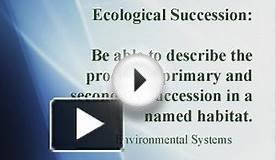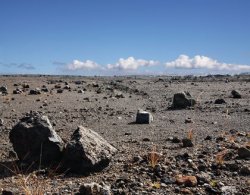Process of ecological succession
Succession is a process of ecological change in which a series of natural communities are established and then replaced over time. Ecologists (scientists who study the relationships of organisms with their living and nonliving environment) generally recognize two kinds of succession, primary succession and secondary succession. Primary succession takes place on an area that is originally completely empty of life. As an example, an area that has been covered by a flow of lava has, for a time, no life at all on it. Over a period of time, however, various kinds of organisms begin to grow in the area. Over time, the variety of life-forms changes as succession continues.
Secondary succession is far more common. It occurs in an area where life once existed but has then been destroyed. For example, imagine a forest that has been destroyed by a wildfire. Again, for a period of time, no living organisms may exist in the area. Before long, however, certain types of plants begin to reappear. And, as with primary succession, the nature of the plant communities gradually change over time.
The stages in ecological succession
The changes that take place during any form of succession depend on a variety of environmental factors, such as the amount of moisture, temperature, and wind. One possible scenario for primary succession might begin with the appearance of simple plants, such as lichens and mosses. Such plants are able to spring up in tiny cracks in the rocks in which water and dissolved minerals collect.
When these pioneer plants die, they decompose and begin to form soil in which other, more complex plants can begin to grow. The second stage of plants might consists of grasses, herbs, and small shrubs. A characteristic of these plants is that they devote a great deal of energy producing huge numbers of seeds. They may live only one year, and spend the greatest part of their energy to ensuring that offspring will arise the following year. Species of this kind are known as opportunist species. Grasses are a common example of opportunist species.
Plants that make up the early stages of succession also die, decompose, and contribute to the growing layer of soil. This process takes place over hundreds or thousands of years, however. Eventually, the soil is able to support more complex plants, such as larger shrubs and small trees including aspen, black spruce, and jack pine. These plants gradually take over from earlier communities since they are taller, have more leaves, and can capture more sunlight that was originally captured by simpler plants.
In the final stages of succession, taller trees begin to grow. They, in turn, block out the sunlight needed by smaller trees and replace them. The final stage of ecological succession is known as a climax community. A climax community in the scenario outlined here might consist of birch, white spruce, and balsam fir.
Secondary succession
The general trends that take place during secondary succession are similar to those for primary succession. Imagine that a forest has been cleared for agriculture and then abandoned at a later date. In this case, a pioneer community consisting of lichens and mosses is not needed. Soil, rich or not, is already available.



|
iPhone 5 case iPhone 5S Case EcologicolSuccessien EcologicolSuccessien Images Redorbit Ecological Processes beautiful design cover case. Wireless (Yeclon)
|
